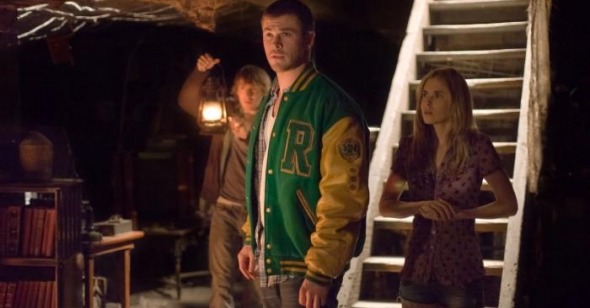Monday Hangover:
The Cabin in the Woods
by Marianna Martin and Chris Wisniewski
Finally. Despite a production history that turned into a private horror scenario for cast and crew when the film’s original scheduled release became collateral damage from MGM’s financial meltdown two years ago, Buffy the Vampire Slayer collaborators Drew Goddard and Joss Whedon’s The Cabin in the Woods has reached screens at last, with a Friday-the-13th release date. And it's the smartest horror film to hit the multiplexes in years. Much of Cabin’s delight stems from the many intricate reveals that comprise the narrative’s structure, but the film is far from gimmicky or contrived, relying on the audience’s fluency in the language of horror films to simultaneously revel in and interrogate the established pleasures of the genre. Cult genre auteur Whedon (producer and cowriter) has made clear his disgust with the “torture porn” genre in past comments, and here he ups the ante with sequences offering perhaps the most damning possible indictment of recent horror clichés (how very tedious they can be in their relentless infliction of suffering). Not that Cabin is here either to praise or bury horror, so much as take it apart and see how the moving parts work, cataloging them in the process.
Cabin’s setup is ostensibly familiar: five young friends pile into an RV and head to a remote location for a weekend of debauchery, unsuspecting of the terrible fates that await them there, and then mayhem ensues. The kids make awful decisions likely to get them killed, as is wont to happen in such narratives. But as the loquacious stoner Marty (“Whedonverse” alum Fran Kranz, a standout) soon insists in a moment dismissed by his companions as paranoia, “puppeteers” are at work to send events down an inevitable path out of their control. Uneasy and knowing laughs follow, as we watch them struggle against their generic fates. Whether those “puppeteers” are merely stand-ins for the producers and consumers of most horror flicks, or part of a sinister supernatural conspiracy, or both, and which of the three is the most horrifying option, is left for the audience to debate. —MM
It’s all about the audience, right? In typically Whedonesque wink-nudge ways, Cabin in the Woods is constantly asking us, “Why do you want to watch these pretty young things get dismembered, disemboweled, and generally mutilated?” Anyone familiar with Whedon’s signature achievement, Buffy the Vampire Slayer, already knows he is particularly adept at working within genre and then subverting it to make a political point, while still managing to give his audience what it wants. With Cabin, Whedon and former Buffy writer Goddard have done it again: the movie manages to be moralizing while still being funny (Merman), scary (Merman), and even a little sexy (one-way mirror). They get to have their cake and eat it, too—as do we, by extension.
Though saying so is a bit of damning with faint praise, Cabin in the Woods is easily the smartest and most knowing American horror film of the past several years. But it’s guilty of an awful lot of cake-eating—that breast shot, a decapitated head getting tossed like a basketball, Chris Hemsworth’s cliff jump. Metageneric self-referentiality aside, the movie at times indulges the very impulses it’s ostensibly critiquing. That may be the point, to some extent, and I am certainly not questioning either Whedon’s or Goddard’s integrity or intentions. The devil here is in the execution, where the scales occasionally tip in the direction of pandering to the audience’s baser instincts and then taking us to task for having those instincts in the first place.
A bigger issue, to my mind, is Goddard’s direction. Though not helped by the murky projection at the multiplex at which I watched the film (seriously, can we talk about the epidemic that is the dimming of the American movie projector?), first-time helmer Goddard doesn’t have the best sense of where to put the camera moment to moment, and as a result Cabin frequently strains to achieve visual coherence. It’s a testament to the intelligent screenplay he and Whedon have written—clever in the best possible way—that Goddard’s directorial shortcomings aren’t a fatal problem. —CW
